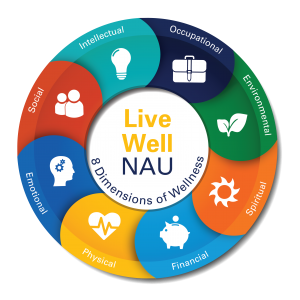Wellness Model
The EAW Wellness Program is based upon ideas and approaches from many fields of knowledge, including wellness, health promotion, health psychology, System Theory, and integrative medicine. The basic model used to integrate these approaches and ideas was adapted from a model developed by Michael O’Donnell, editor of the American Journal of Health Promotion, and focuses upon:
- increasing awareness of wellness issues (information);
- supporting health management (personal change);
- promoting healthy work climates (organizational support).
Read more Accordion Closed
Health is a state of complete physical, mental and social well-being and not merely the absence of disease or infirmity. – World Health Organization
Health promotion is the science and art of helping people change their lifestyle to move toward a state of optimal health.
Wellness as a process (definitions):
Developing awareness that there is no end point, but that health and happiness are possible in each moment, here and now, an active process of becoming aware of and making choices toward a more successful existence. (Travis, J.W. & Ryan, R. S., The Wellness Workbook);
A holistic concept: it is looking at the whole person, not just their blood pressure, body fat, exercise behavior or what a person had for lunch. It involves physical, social, emotional, occupational, spiritual, and intellectual dimensions. (National Wellness Institute)
“If one imagines each aspect as a spoke on a wheel, Wellness helps a person extend the physical, social, occupational, and intellectual aspects out as far as they can be developed and practiced. Therefore, a wellness mindset seeks to grow in each dimension, not just one, so that the wheel rolls smoothly.”
– National Wellness Conference
Physical wellness: a perception and expectation of physical health.
Spiritual wellness: a positive perception of meaning and purpose in life.
Psychosocial wellness: a general expectation that one will experience positive outcomes to the events and circumstances of life.
Social wellness: a perception of having support available from family, friends, or co-workers in times of need and a perception of being a valued support provider.
Emotional wellness: possession of a secure self-identity and a positive sense of self-regard; also the ability to cope with and/or improve unpleasant mood states.
Intellectual wellness: the perception of being internally energized by an optimal amount of intellectually stimulating activity.
Assumptions and guiding principles of the wellness model
- The well being of every individual within an organization influences the well being of the organization (and vice versa).
- Within an organization, individual and organizational well being are maintained and advanced through a combination of individual self-regulation and cooperation between individuals.
Read more Accordion Closed
- Individuals and organizations tend to seek balance between: (a) maintaining the current level of functioning and (b) pursuing further development.
- The safer and more supported an individual feels within an organization, the more likely she will develop higher levels of wellness.
- Healthy patterns develop in increments, rather than all at once.
- Health risk reduction and prevention or alleviation of illness are not identical to wellness enhancement. Optimal health is achieved by accomplishing both.
EAW wellness programs
The EAW office provides three levels of wellness programming: 1) providing information, 2) facilitating personal change, and 3) facilitating organizational change.
Read more Accordion Closed
- Information: designed to support healthier lifestyle choices (e.g. books, brochures, website resources, etc.).
- Personal change: workshops, seminars, classes, individual counseling, and other activities.
- Organizational support: assistance in establishing more supportive work sites (via consultation and involvement in related projects).
Stages of change readiness
The EAW wellness program recognizes that each individual is not equally motivated to seek personal changes in his/her level of health and well being. The following change readiness model (developed by Prochaska & DiClemente) is used in tailoring wellness programs according to varying levels of motivation:
Read more Accordion Closed
Precontemplation – no intention to make changes in a given area right now
Contemplation – intention to make changes in a given area within the next 6 months
Preparation – intention to make changes in a given area within the next month
Action – changes in a given area have been started (but not completed) within the last 6 months
Maintenance – desired changes have been maintained for more than 6 months
Relapse – there exists a perception of a loss of control over making desired changes (may occur in any stage
(Please do not email sensitive information, as email is not a private or confidential form of communication.)
